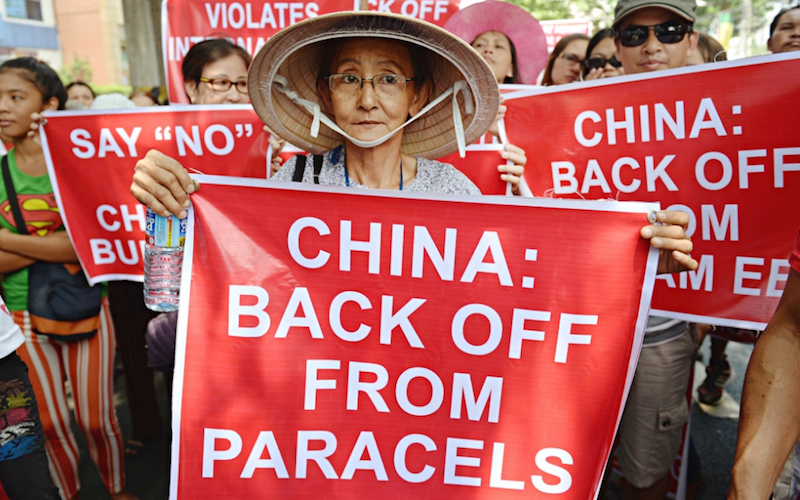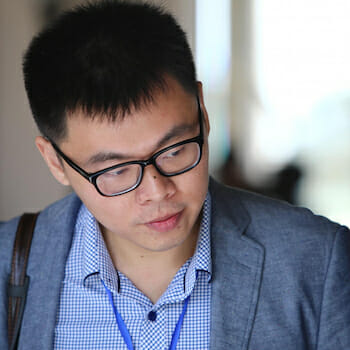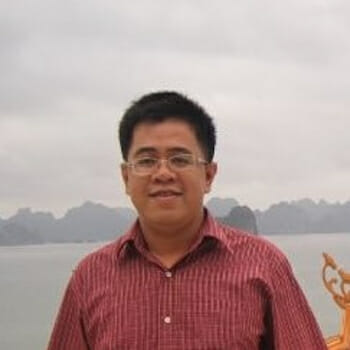
A U.S.-Vietnam Alliance or (still) a U.S.-China-Vietnam Triangle?
In the wake of the Chinese drilling oil rig incident last May, many pro-Western observers had a beaming sense of optimism about the bright prospect of U.S.-Vietnam relations. The basis for this viewpoint is grounded in an unrelenting series of exchanges from both sides. On July 21, Hanoi Party Chief Pham Quang Nghi visited the U.S, meeting with President pro tempore of the U.S. Senate Patrick Leary, even though his trip was a low-key affair. On August 14, U.S. Army General Martin Dempsey became the first chairman of the Joint Chiefs of Staff to visit Vietnam in more than four decades. This trip reflects both countries’ intention to forge closer military relations.
One week ahead of Gen. Dempsey’s visit was the trip made by Senators John McCain and Sheldon Whitehouse. They all support the termination of the U.S. ban on lethal arms sales to Vietnam. On September 15, Vietnam’s Deputy Prime Minister Vu Van Ninh began his five-day visit to the U.S. to prompt Trans-Pacific Partnership negotiations and beef up the two countries’ economic ties, which Vietnam hopes to use to improve its economic competitiveness, reduce its reliance on China, and contribute to modernization. These important developments finally culminated in an agreement that was made during Deputy PM Pham Binh Minh’s visit to the U.S this month, where the U.S agreed to ease its weapon embargo against Vietnam for maritime patrol security. These fast-paced trips signal Vietnam and the U.S. have entered a new era in their relationship since the normalization of relations in 1995, owing largely to the China factor.
However, Vietnam also finds a subtle way to assuage China’s dissatisfaction towards its active hedging diplomacy. Last August, the Standing Secretary of the Vietnamese Communist Party Le Hong Anh visited China as a special envoy of the party chief. Vietnam’s official media reported the trip’s primary motive as restoring and improving the relationship between two communist parties and countries. Anh, ranked fifth in the Politburo, met with numerous high-ranking Chinese officials, including President Xi Jinping. Vietnamese and Chinese news agencies announced that a three-point agreement was reached during the visit: 1. Leaders of the two communist parties and states will further enhance their direct guidance on the development of their bilateral relations; 2. Intraparty communications will be strengthened; 3. Prior consensus between the two parties and countries will be kept up to maintain the overall situation of the Sino-Vietnamese relationship and peace and stability in the South China Sea.
Le Hong Anh’s trip was not the first time Hanoi has shown a gesture of deference. In October 2011, Vietnam’s Communist Party General Secretary Nguyen Phu Trong also visited China to cool down the tensions that had flared up around five months earlier.
In May and June 2011, Chinese vessels twice cut cables towing the sonar array of PetroVietnam’s boats in Vietnam’s exclusive economic zone under the 1982 UNCLOS. These incidents sparked public protests in Vietnam. China and Vietnam exchanged accused each other of violations of territorial waters. The Vietnamese party leader’s trip to China was deemed to be a welcome détente, calling for China to set up a hotline to diffuse emergencies between two countries. He did not reap any long-term solution to the dispute, but at least eased the ongoing stand-off at that time.
Anh’s trip was also regarded as a signal from Vietnam to show that they do not want to confront China in the context of a recent visit to Vietnam by the first U.S. Chairman of the Joint Chiefs of Staff since 1971 – General Martin Dempsey. This, in turn, was also considered a diplomatic success for Beijing in making sure that Vietnam still complies with the bilateral mechanism to resolve disputes. During his talk with Xi Jinping, Le Hong Anh said that Vietnam would do their utmost to enhance mutual understanding and trust, and consolidate the comprehensive strategic partnership with China.
The above inconsistent signals demonstrate the variety of opinions in the “alliance debate” happening in Vietnam now. The main purpose is to place the “three NOs” national defense policy at the center of criticisms. This policy has long insisted on three principles that are deemed unchangeable: no military alliances, no allowance for any country to set up military bases on Vietnamese territory, and no reliance on any countries for help in combating other countries. Within the Vietnamese inner circle, numerous criticisms claim that this policy no longer benefits the protection of national interests and sovereignty, especially after China placed the US-981 oil rig in Vietnam’s EEZ. Though varying in approaches and degrees, these suggestions all try to push Vietnam closer to the United States. From the point of view of Vietnamese strategists, only the United States can alter China’s calculus towards the South China Sea in ways that would deter China from using military force or coercion to settle disputes. In dealing with territory disputes in the South China Sea, Vietnam can rely on the United States as a security warranty.
The degree to which the United States acts as a security warranty depends on the content of the pact. Meanwhile, being backed by a military great power means a desirable change in the power balance (especially in terms of military power in South China Sea disputes). Unlike the Philippines, Vietnam is in conflict with China in both the Paracel and Spratly islands. While the Spratly islands involve many other SEA nations and directly affect regional maritime freedom, disputes on Paracel remain merely a bilateral issue between Vietnam and China. After the events of the HD-981 oil rig, Vietnamese strategists have realized that it is difficult to attach territory conflicts to maritime freedom, the latter of which has gained obvious concern from the United States. Therefore, with neither an alliance nor military support, Vietnam will be hurt in confronting China at Paracel.
In April 2014, two U.S. navy ships had the fifth annual six-days of joint non-combat exercises with the Vietnamese navy, symbolizing a closer defense cooperation between the two former adversaries. However non-combatant, these exercises forge the basis for building mutual trust and understanding between the U.S. and Vietnam, hopefully catering to each other’s priorities. For instance, during his trip to Vietnam last December, U.S. Secretary of State John Kerry announced that the Vietnamese Coast Guard would receive $18 million in aid with five fast patrol-boats to enhance its maritime police capacity.
Recently, there has been more vocal support from American congressmen for the lifting of the U.S. ban on the sale of lethal weapons to Hanoi. Gen. Dempsey also mentioned that the Pentagon could sell Vietnam better equipment for maritime surveillance, including radar and surveillance aircraft. Vietnamese maritime surveillance and defense capabilities could be augmented with initial purchases of U.S weapon systems such as the P-3 Orion surveillance planes. Given its anti-submarine capability, the P-3 Orion is especially important for Vietnam’s early detection of submarines in the South China Sea as well as for Vietnam’s development of anti-access capabilities. These concrete steps bode well for building a future alliance. Yet, Vietnam and the U.S. are still reserved about the other’s intentions. Sanguine expectations that Hanoi will enter Washington alliance system require careful evaluations of Vietnamese leaders’ mindsets.
Firstly, Vietnam does not want to see an improved relationship with the U.S. come at the expense of its continued relations with China. It is always in Vietnam’s strategic thinking that geopolitical proximity plays a very important role. Hanoi will not risk ruining their relationship with China in order to make an alliance with the U.S. Vietnam and China have already established an institutionalized mechanism to undergird their bilateral relationship with annual high-ranking official visits and frequent discussions on border issues, maritime security, defense cooperation, territorial waters, and joint fishing activities. Even though China is increasingly aggressive in the South China Sea disputes, Vietnam keeps reiterating the critical importance of a friendly relationship with China. Vietnamese policy makers do not want to see their strengthened relationship with the U.S. disproportional to frayed Sino-Vietnamese relations in a zero-sum game.
The U.S.-Vietnam alliance is better seen as a destabilizing factor in the Washington-Hanoi-Beijing triangle. They believe that walking a delicate balancing act between these superpowers can still work for them. Besides, this tactic does not violate their non-alliance principle. It is the pragmatic rationalization that defines Vietnamese foreign policy: enhancing defense and economic times with the U.S. while maintaining a good relationship with the northern juggernaut.
Secondly, Vietnam’s economy is vulnerable to ripple effects from a confrontation with China. In 1991, bilateral trade was only US$32 million. China is now Vietnam’s largest trading partner, totaling up to US$50.21 billion in 2013, while bilateral trade with the U.S. in 2013 was US$30 billion. Sino-Vietnamese trade is expected to reach US$60 billion, a double-digit annual increase. Conservative Vietnamese leaders might learn an ongoing lesson from Europe as Ukraine economy is heavily hit by Russian economic pressure and sanctions. A Vietnamese report says the impact of China’s unilateral deployment of an offshore drilling rig into Vietnam’s exclusive economic zone might cost Vietnam’s economy $1.0-1.5 billion. The figure could have been bigger if China had not one-sidedly withdrawn the rig sooner than scheduled. China is also the country that Vietnam has the biggest trade gap with. The trade balance in China’s favor has become wider over the years. When we look at bilateral trade components, it is worth noting that unprocessed goods, such as crude oil and coal, account for a significant proportion of Vietnam’s export basket to China.
The problems deepen for Vietnam’s production industry, as enterprises, even export-centric ones, are becoming more reliant on Chinese input materials for value-chain production. Imported goods from China to Vietnam encompass various essential materials for export-specified production, including raw materials, machinery and equipment, steel, chemicals, oil and fabrics. Le Dang Doanh, a Vietnamese economist, has frequently expressed his frustration about the trade imbalance and economic dependency on China. He said, “Vietnam exports coal and then imports power. It exports rubber and imports car tires.” Specifically, Vietnam is now importing nearly 50% of yarns and fabrics needed for its textile industry from China. If China disrupts the yarn supply, it will greatly damage Vietnam’s garment industry, culminating in mass unemployment in this labor-intensive industry.
Thirdly, human rights are considered to be the most thorny, contentious issue in the bilateral relationship. This issue can hamper the potential of the relationship to reach its full development, but it does not necessarily mean other ties will be dramatically affected. The U.S. hopes that deepening relations in other fields will help encourage Hanoi to loosen its tight grip on human rights conditions. Some American politicians argue that Washington could use the weapons ban and TPP negotiations as political leverage to pressure Hanoi to release political dissidents and promote more democratic reforms. Some might argue attaching these conditions could lead to a vicious cycle. Vietnam might tighten or relax its control on human rights correspondingly to whether they have achieved their aims. The U.S. Assistant Secretary of State for democracy, human rights and labor, Tom P. Milnowski, commented that Vietnam’s “positive” improvements on human rights in the last half year would be factored into the final decision on lifting the weapons sale ban. It is still uncertain how much Vietnam is willing to sacrifice to join the Trans-Pacific Partnership. The TPP requires members to embrace strong labor provisions, including freedom of association, and allowances for collective bargaining, and Vietnam needs to make changes to abide by these rules. One of the most notable points is the establishment of independent trade unions.
Fourthly, the lesson that history might repeat itself is still etched in Vietnamese leaders’ mind. The memories of the current leadership have not faded easily. In 1978, Vietnam joined the Soviet-led Council for Mutual Economic Cooperation and subsequently inked the Treaty of Friendship and Cooperation with the Soviet Union. Owing to the aggravating Sino-Soviet rift, China immediately interpreted this treaty as a military alliance against China. Obviously, it was Hanoi’s close intimacy with Moscow that infuriated Deng Xiaoping, who then labeled Vietnam “a hooligan” and, even worse, China did not stop at verbal denouncement. Beijing was determined to teach “the ungrateful Cuba of the East” a lesson, leading to a four-week bloody incursion into Vietnam’s territory in February 1979. Valuable lessons were drawn on both sides.
For Vietnam, the implications that the Soviet Union failed to protect Vietnam under the Treaty of Amity from Chinese invasion were twofold. First, it was too risky to cultivate a close relationship with a faraway rival of a next-door neighbor (ban lang gieng gan, mua ba con xa). Threats at the gates are always much bigger in scale than promising windfalls from friends afar. Second, great power politics leave few options to small nations. Getting involved in tensions between great powers is not a smart move. Hence, Vietnamese leaders opted out of the conflict between China and the Soviet Union around forty years ago. Deeply aware of the power asymmetry with China, current Vietnamese policymakers are arguably dubious of any benefits that an alliance with the U.S. can bring about.
The consequences of a sour relationship with the northern neighboring giant are no stranger to the Vietnamese. Forty years earlier, South Vietnamese President Nguyen Van Thieu also had the hard experience with the U.S. in the Vietnam War. He accused the U.S. Secretary of State Henry Kissinger of having tricked him into signing the Paris Accord by promising more military aids which then turned out to be lip service. Mr. Thieu believed that his American allies had betrayed him by “playing the China card” to resolve the war without his knowledge and informed consent, culminating in the fall of Saigon in 1975. Current Vietnamese leaders must have known the nature of this alliance of convenience very well since they exploited it to win the war. For sure, they do not want to be in the same awkward situation with the U.S. that the South Vietnam government was.
The Washington-Hanoi-Beijing security triangle has emerged as the result of the changing landscape after the Cold War. The strategic ambiguity of both the U.S. and China has led to uncertainty in the region – a state of affairs that small and middle states have to cope with. As a result, a “strategic ambiguity” from below has emerged. For a decade, Hanoi has been seeking to preserve a “delicate equilibrium” between the great powers by employing a careful mix of diplomatic, economic and security measures to both softly balance China’s growing power and to bind China through economic interdependence and bilateral and multilateral agreements.
In the face of Chinese aggression in the South China Sea, the status quo has changed, which has destroyed this delicate equilibrium. Nonetheless, the probability of a new U.S.-Vietnam alliance runs the clear and present risk of irreversibly antagonizing China. The crisis in Ukraine, currently the flashpoint between Washington and Moscow, might also befuddle Vietnamese leaders a bit about the possibility that they could provoke a serious response from China when they seek deeper strategic relations with the U.S. and its allies. It is self-evident that Ukraine is different from Vietnam in many aspects, but the analogy can shed light on how fiercely a big power can react to a perceived threat when its traditional obedient smaller neighbor is tilting towards U.S.-led NATO. The Washington-Hanoi-Beijing security triangle is in flux, and the U.S.-Vietnam alliance’s reality is still a bit away from what the future is supposed to deliver.


